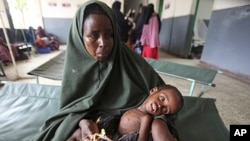As the Horn of Africa suffers through its worst drought in 60 years, governments and humanitarian agencies are responding to the immediate needs of millions of people, namely for food and water. But there are calls for long-term solutions to help the region break the cycle of humanitarian emergencies.
The International Fund for Development (IFAD) says there’s much that can be done to deal with recurring droughts.
“They’re not only ongoing, but they seem to be increasing in frequency over the past 20 years. And this is probably attributable to climate change,” said Geoffrey Livingston, IFAD’s regional economist for the Horn of Africa. He added, “There doesn’t seem to be a great deal of mitigation measures from one drought to the next.”
Emergency response, long-term measures
Aid agencies, which say as many as 10 million people are at risk, are appealing for millions of dollars to fund emergency programs.
“Droughts are endemic to the Horn of Africa. However, each time it happens, these droughts bring an incredible amount of distress and the resilient mechanisms that need to be in place aren’t yet in place,” he said.
IFAD has warned the effects of drought “cascade through countries in the form of higher food and fodder prices, civil unrest and diminished social services as governments redeploy budgets to meet the most pressing needs of their citizens.”
IFAD has a number of programs in the Horn to try to “build resilience.”
“When we talk about resilience, we’re talking about the ability for farming communities to…get some harvest when there are less rains…through the use of drought resistant seeds…on-farm storage capacity, so that when a farmer has an ok harvest he or she is able to put that harvest aside and have something in reserve for when the rains fail,” said Livingston.
Other measures include pro-active efforts by governments to provide emergency services for herders, including feed supplements and financing for fodder. There are also techniques to harvest what little rain does fall.
“Of course,” he said, “When there’s no rain at all, their utility is less. But if there are these things in place then it can make a bad situation be a little bit more livable.”
Time and commitment
Such resilience-building measures cannot be put in place overnight. In a country like Somalia, for example, the devastation of the drought is being compounded by conflict. Many thousands of Somalis have fled to neighboring countries to find food and water. Aid agencies were are? often unable to reach those in need.
But Livingston said, “With concerted effort by the donor community and the required investment and cooperation by the concerned governments, I think an awful lot can be achieved in a five to seven year period.”
If those measures are not put in place, he said, “You’ll see these almost-annual cycles of devastation on a yearly basis.”
Since 1978, IFAD, based in Rome, has invested nearly $13 billion in grants and low-interest loans to developing countries.











